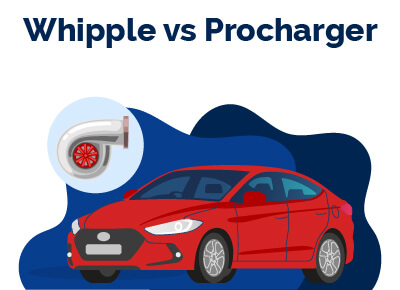Whipple vs. ProCharger: A Detailed Comparison
May 30, 2023


Chris is Head of Content for FindTheBestCarPrice and is based out of Philadelphia, PA. As a seasoned automotive industry analyst and car enthusiast, he ensures the highest level of quality across all our content and curates our picks for the best deals each month.
Chris studied information systems and marketing at Drexel University and writes about a wide range of topics ranging from car buying tips to troubleshooting common mechanical issues.
When he’s not thinking about cars, he likes to stay in with his dog and make an “attempt” to finish a crossword puzzle (he’s not quite at the Saturday/Sunday level…yet). As a former cheesemonger, Chris still has a “sharp” passion for all things cheese, and his fridge is always loaded with it!
Chris also has a passion for things that go fast, and drones are no exception. He spends some of his time writing for Dronesourced.
A lot of times, all that we need is just an extra speed, more horsepower, more torque, great power, and engine efficiency, enough to blast us through town. This has made superchargers an enticing option for racing enthusiasts and drivers that wish to customize their cars for racing.
ProChargers and Whipple are renowned American supercharger manufacturers, and based on how good both brands are, it's always a tough decision trying to decide which is better between Whipple vs. ProCharger.
Whipple and ProCharger adopt different mechanisms in their production. For instance, Whipples are positive displacement types, while ProChargers are more of the centrifugal type. ProChargers are lightweight, make less noise, and demand less fuel compared to, but Whipple offers great power even at lower revs.
Let's dive deep into explaining the similarities and differences between these components to help you decide the best for you.
Table of Contents
Whipple vs. ProCharger: Everything You Need to Know
| Features | Whipple | ProCharger |
| Performance | ||
| Noise | ||
| Durability | ||
| Cost | ||
| Fuel efficiency | ||
| Engine Structure and Design |
Whipple SuperCharger: Overview
Whipple is a brand that produces some of the best superchargers. Owned by Art Whipple, located in Fresno, California, the Whipple brand runs the operation and production of some of the most successful racing superchargers.
Just like most superchargers, Whipple increases engine power and torque by compressing and inhaling gas, thereby forcing more air and pressure into the engine.
Whipple started as a twin-screw supercharger while adopting a positive displacement type. By adopting a positive displacement design, Whipples ensure a constant boost level across all engine speeds. This implies that the moment you step on the gas pedal, you'll notice a drastic increase in speed and power.
Whipple's design features the use of two blades carefully designed to resemble helical gears, which extend to the end of the vehicle.
The operation of these blades forces air through the supercharger, compressing them further as they are compressed internally across the male and female rotors. This process continues until all available spaces are used and enough power is generated for your car.
Both rotors are designed to rotate in opposite directions; the male rotates clockwise, and the female rotates anti-clockwise.
The rotation pushes air to the front of the machine, but it is important to me, too, that air is stored up in the rotors until the motor requires charged air. This ensures a sustainable supply of fresh, cold, and clean air with no parasitic losses.
ProCharger: Overview
Like Whipple, ProCharger is a brand that produces some great superchargers, good enough to compete with Whipples. However, there are differences between both brands; their engine structure, design, and power delivery.
ProChargers adopt a centrifugal design that makes them operate differently than the average supercharger. Unlike the Whipples, the ProCharger centrifugal design integrated the use of centrifugal force to increase manifold air pressure.
ProCharger's design features an impeller, a rotating device that ensures inward air intake by spinning at high speeds. Just as air enters through the center of the impeller, there's a cylindrical outward dispersal to achieve high pressure through conversions by a diffuser.
Unlike the dynamic displacement system, Whipples, as a positive displacement supercharger, achieved smoother power delivery by sustaining a continuous flow of air in the motor instead of through bursts.
What Is the Difference Between a Whipple and ProCharger?
Aside from the fact that Whipple and ProChargers are both superchargers, there are a lot of differences that set both brands apart from each other.
The differences and similarities drive down to the level of torque, horsepower, and boost settings that both superchargers offer.
While we understand that it will be a hard choice to decide which is better, the best we can do is to differentiate superchargers from both brands to help you make a solid decision.
Performance: Boost Pressure
The truth is, whether you choose a Whipple or a ProCharger, you'll get a noticeable power boost in your engines. However, there are a few differences between superchargers from both brands that will help you decide which one is the best for you.
The differences in the performance of Whipple and ProCharger spreads across their power output, torque, boost, and efficiency.
Both the Whipple and ProCharger offer a comparable overall power output at minimal boost settings. But, at higher boost pressures, Whipple produces more power owing to its larger impeller diameter.
The differences in power delivery between Whipple and ProCharger start from how they control heat during air intake. Superchargers with hotter air intake will achieve lesser performance compared to those with colder air.
A close comparison of Whipple and ProCharger products reveals that ProCharger superchargers achieve colder air intake, which translates to better performance.
You'll get more power on ProChargers than on, although this varies depending on the size of the supercharger you are opting for.
One of the significant differences in the performance of Whipple and ProCharger is that Whipple adopts a positive displacement system, while ProChargers are centrifugal.
This makes Whipple a better choice for more power at low RPMs. They will start strong but lose steam as you hit the gas pedal to a higher RPM.
ProChargers are more linear and offer predictable power and a better burst of speed at high levels. However, there's a big change in the boost pressure and maximum boost of Whipple and ProCharger.
ProCharger works with your car's engine to ensure the power generated is within your engine's RPM. For Whipple, the maximum boost that you'll get is in no way related or dependent on your car's RPM.
It can go beyond your engine's Capacity by pushing more compressed air into your engine, more than your engine can contain. This might sound scary, but it only ensures that the supercharger maintains a stable boost in your engine without depending on the engine's RPM.
Whipple also has better boost pressure than ProCharger. Both superchargers are great for performance. You just have to choose the one that works for you.
Whipple superchargers offer more low-end torque and instant throttle response, which is ideal for towing, drag racing, or off-road driving. Still, ProCharger superchargers offer more high-end horsepower and efficiency, which is ideal for racing or daily driving.
Winner: Both
Whipple vs. ProCharger: Noise
Aside from the extra power they offer, there's this amazing sound that comes with a loud, aggressive, screeching, whistling noise that you can't ignore.
However, sometimes the noise can become too loud that they become a less admirable factor.
In terms of noise, ProCharger is less noisy, unlike Whipple, which delivers an annoying sound when you rev your engine. This is due to the fact that Whipple is mounted on top of your engine, and the company utilizes a twin screw design that produces a sound that can be annoying to your ears.
ProChargers are mounted in front of your engine. The sounds from ProChargers are more of a blend of humming and soft whining sounds that won't harm your ears.
However, lately, the Whipple brand has employed different noise cancellation techniques to reduce the amount of noise those superchargers make. Yet, it doesn't beat ProCharger's quiet state.
Winner: ProCharger
Whipple vs. ProCharger: Durability
It's indisputable that ProChargers are more durable than Whipple. It's speculative that Whipple can last up to 200,000 miles, although this greatly depends on your maintenance culture.
However, the ProCharger brand grants users the assurance of longevity and Reliability. These components can last more than 250,000 miles, with a trouble-free life span of 150,000 to 200,000 miles.
Winner: ProCharger
Whipple vs. ProCharger: Cost
Whipple superchargers are relatively more expensive than ProCharger superchargers. However, this depends on the version and size that you are going for.
We cannot rule in the assumption that Whipple has more brand value than ProCharger, but we believe that the reason why superchargers are more expensive is due to the fact that they have more components to work with.
This includes the fact that Whipple superchargers require more installation time than ProCharger superchargers.
Winner: ProCharger
Whipple vs. ProCharger: Fuel Efficiency
If you're a big fan of fuel efficiency, then we'll advise that you stay clear of Whipple superchargers. Their superchargers will trash your fuel efficiency, making your gas mileage worse than you can imagine.
They require more air volume, they consume more heat, and this drastically impacts your gas mileage. The excessive pumping of air into your engine to deliver more power takes a great toll on your fuel efficiency.
Winner: ProCharger
Whipple vs. ProCharger: Engine Structure and Design
The designs of Whipple and ProChargers are entirely different, and this also relates to their engine structure.
Whipple superchargers are positive displacement types, which means they deliver a constant amount of air at any engine speed. In contrast, ProCharger superchargers are centrifugal type, which means they deliver more air as the engine speed increases.
Whipple superchargers have a twin-screw design that compresses the air inside the rotor housing, while ProCharger superchargers have an impeller design that compresses the air outside the housing. ProCharger adopts the use of aluminum turbine housing which is more durable than Whipple's Iron housing shell.
Winner: ProCharger
Whipple: Pros and Cons
Pros
- Ideal for towing, drag racing, or off-road driving
- Better performance at low RPMs.
Cons
- Generates more heat.
- Costly.
- More installation time.
- Noisy.
ProCharger: Pros and Cons
Pros
- Ideal for racing or daily driving.
- ProCharger superchargers achieve colder air intake, which translates to better performance.
- Easy installation.
- Cheaper.
Cons
- Poor performance at low RPMs.
Is a ProCharger Better Than a Whipple Supercharger?
Considering that a ProCharger has more benefits than a Whipple supercharger, it's easier to say they are better than a Whipple. With ProCharger, you are getting a less noisy supercharger, an easier installation process, less costly, and more durability standards.
However, it's important to mention that both brands design superchargers that are structured to achieve different aims.
Conclusion
Whipple and ProCharger are two popular brands of superchargers that boost the performance of your engine by forcing more air into the combustion chamber.
While it's obvious that ProCharger beats Whipple in many categories, you must make your choice according to your driving needs and budget.
Best Car Deals by Category
Posted in Car Buying Tips, Car Troubleshooting |




